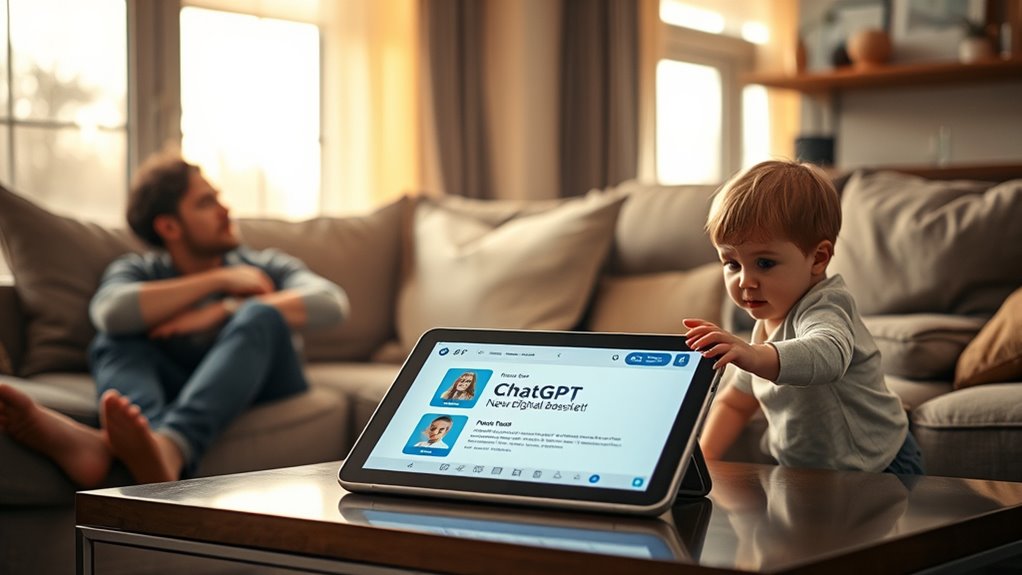ChatGPT is quickly becoming a virtual babysitter for screen-weary parents, offering a safe, interactive way to engage children. It provides educational stories, answers urgent questions, and helps plan daily routines—all accessible anytime. While it can’t replace physical supervision or emotional bonds, it offers a cost-effective, flexible supplement to traditional childcare. If you want to see how this innovation can support your family, there’s more to discover below.
Key Takeaways
- ChatGPT offers on-demand, interactive storytelling and educational content, engaging children without screen fatigue.
- It provides immediate answers and activity planning, reducing parents’ reliance on constant supervision.
- AI-driven virtual babysitting supports busy or screen-weary parents seeking flexible childcare solutions.
- Integration with smart devices allows remote monitoring and assistance during virtual caregiving sessions.
- While not a replacement for physical care, ChatGPT supplements traditional babysitting, easing parental screen time concerns.

As technology advances, ChatGPT is emerging as a new kind of babysitter, offering parents a flexible and accessible childcare support option. With the global babysitting services market expected to hit between $31.83 billion in 2025 and $37.28 billion by 2033, it’s clear that parents are seeking innovative ways to manage childcare. The rise in dual-income households, increased female workforce participation, and evolving family structures are fueling this growth. Meanwhile, advancements in digital platforms and technology are making virtual babysitting a practical solution, especially as COVID-19 temporarily disrupted in-person services but accelerated interest in remote options. Additionally, the increasing adoption of digital solutions in childcare reflects a broader trend of integrating technology to meet modern parenting needs. This shift highlights how technological innovation is transforming traditional childcare models. By 2025, over 800 million weekly users engage with ChatGPT, showing its widespread adoption and potential as a parenting tool. More than half of parents, around 52.7%, use ChatGPT to answer childcare questions, highlighting its role in supporting daily parenting tasks. This AI tool can provide on-demand information, supplementing or even partially replacing traditional babysitting for cognitive engagement. Its natural language processing creates interactions that feel human-like, with about 63.5% of users unable to tell AI-generated text apart from real conversations, making it engaging and accessible for children.
ChatGPT serves multiple functions as a babysitter. It offers interactive storytelling and educational content, keeping children engaged mentally without direct supervision. Parents can rely on it to answer urgent questions about child behavior, development, or health around the clock. It can help plan daily routines or activities, making childcare more structured and manageable. Additionally, ChatGPT fosters language development through conversational interaction, encouraging children to improve communication skills. It can even support remote monitoring by providing alerts or suggestions when parents supervise children virtually, adding another layer of oversight.
Compared to traditional babysitting, ChatGPT is scalable and cost-effective, eliminating the need for physical presence. It’s ideal for busy or single parents needing flexible care options. Its immediate, tailored responses can be accessed anytime, reducing logistical barriers. When integrated with smart home and educational devices, it creates a seamless engagement environment. Plus, it minimizes exposure to illnesses and emergencies by limiting human contact, offering a safer alternative during health crises. The global market for babysitting services is expanding rapidly, reflecting a growing demand for innovative childcare solutions.
However, ChatGPT does have limitations. It cannot replace physical supervision, especially for younger children, nor can it replicate the emotional bonding a human caregiver provides. Its interaction quality depends on parental input, and privacy concerns about data sharing remain. Despite these challenges, ChatGPT is proving to be a promising supplement, helping parents navigate the complexities of modern childcare.
Frequently Asked Questions
Can Chatgpt Replace Human Babysitters Entirely?
No, ChatGPT can’t replace human babysitters entirely. You need physical supervision, emotional bonding, and quick responses to emergencies—all things AI can’t provide. While ChatGPT can help with educational activities and administrative tasks, it lacks the ability to guarantee your child’s safety and meet their emotional needs. You should use it as a support tool, not a replacement for caring, attentive human caregivers.
How Does Chatgpt Ensure Child Safety During Interactions?
Imagine a guardian angel watching over your child’s digital interactions. You see, ChatGPT guarantees safety by filtering out harmful content, routing minors to age-appropriate versions, and detecting signs of distress or danger. You can customize controls like quiet hours or disable features, giving you peace of mind. While it’s not perfect, the system’s safety features, combined with your oversight, help protect your child during every conversation.
What Age Groups Are Suitable for Chatgpt as a Babysitter?
You should consider using ChatGPT as a babysitter mainly for children aged 6 to 10, but only with strict adult supervision. For older kids, like those 11 to 13, partial supervision is better, allowing educational use within boundaries. Teenagers 14 and up can have more independence, but ongoing guidance is still essential. Always set clear rules, monitor interactions, and prioritize safety to make certain responsible use of AI in caregiving.
Are There Privacy Concerns With Children Using Chatgpt?
Did you know that AI tools like ChatGPT gather user data, raising privacy concerns for children? You might worry about this because minors’ information could be at risk. While parental controls and content restrictions help, the FTC and regulators are scrutinizing these tools more. You should stay informed, set clear boundaries, and use available controls to protect your kids and ensure their safety while they chat.
How Does Chatgpt Handle Emergencies or Unexpected Situations?
When you ask ChatGPT about emergencies or unexpected situations, it analyzes the details you provide and offers guidance based on its training data. It can suggest actions, generate emergency procedures, or provide quick information to help you respond. However, you should remember it’s not a substitute for professional responders, and you need to verify its advice with trusted sources. Always prioritize contacting emergency services when needed.
Conclusion
So, next time you’re desperate for a break, just fire up ChatGPT. It’s basically the superhero of babysitters, capable of entertaining your kids with endless stories, games, and answers at the flick of a switch. Forget traditional babysitters—this AI marvel is like having a super-powered, 24/7 nanny who never gets tired or calls in sick. With ChatGPT around, you might just finally get some peace—and maybe even a moment to breathe.









